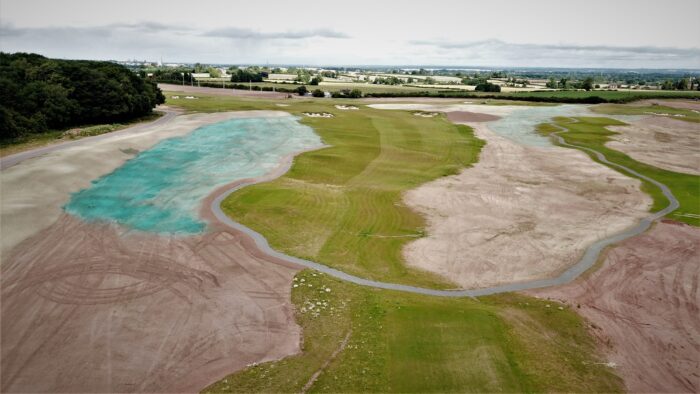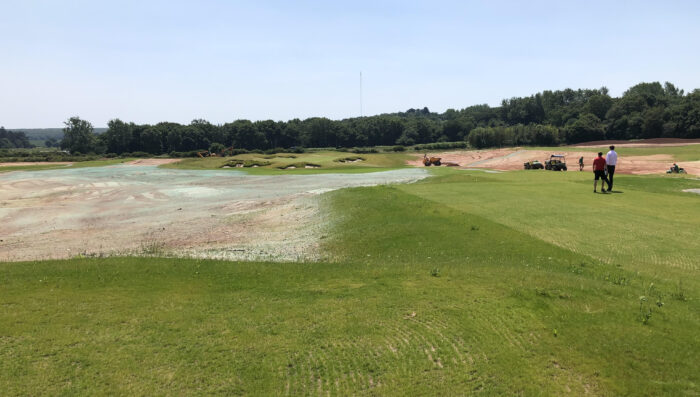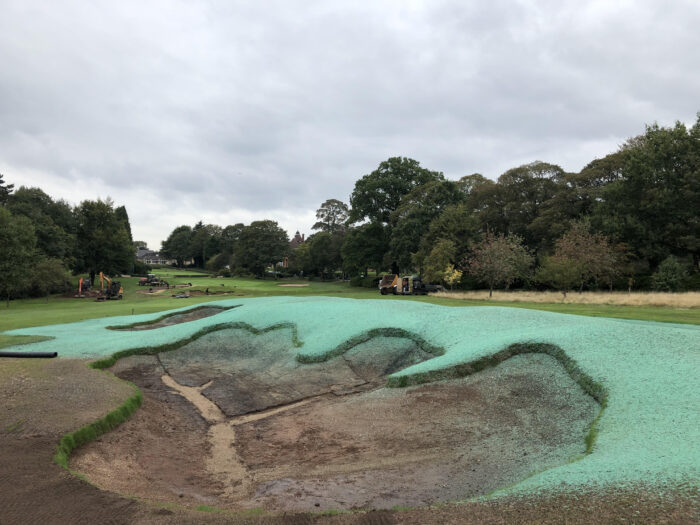How these clubs remained open despite huge course renovation projects
Two huge course redevelopment projects in the UK in recent years have been at Whittington Heath, which was reconfigured and extended due to the HS2 project, and at Moor Hall, which renovated all its bunkers in one go. In both cases the main contractor was John Greasley Ltd, which details here what was done and how the playing of golf continued during the works.
It is quite often the case that golf clubs continue to operate in tandem with construction and renovation works being carried out on their courses. This has been the case at two Staffordshire clubs that have been worked on simultaneously by the same contractor, John Greasley Ltd. The company is used to working throughout the UK and Europe but has been blessed with two very local contracts down the road from its headquarters in Uttoxeter.
Whittington Heath Golf Club – HS2 related extension and course reconfiguration
What began at the start of 2019 as a major course reconfiguration project, moved onto the construction of five completely new holes spread over 69 acres. Phase 1 encompassed the rebuilding of all relevant bunkering to the holes due to remain, along with the formation of newly positioned tees, fairways and greens / surrounds. A completely new irrigation system was also installed to the existing courses’ long term layout by sub-contractor Irrigation Control. The installation by Phil Breakey’s team was impeccable, with very little disruption to golf or indeed playing surfaces. Both the construction and irrigation teams worked alongside the members who continued to play 18 holes of golf throughout, albeit in a temporary layout.

Whittington Heath
By April 2019 we moved onto the new land allowing the season to proceed un-interrupted. The club had the benefit of playing out of all the newly constructed bunkers by early May that year, in part helped by the early sequencing of turfing the surrounds through February and March. The turnaround and establishment period was tight, but helped along with favourable conditions for both construction and growing in (the February heatwave did cause some stress for both contractor and newly laid turf!)
Phase 2 got underway at the start of April on the adjacent ‘New Land’ with the new holes being seeded throughout the summer. A total of nine new USGA style greens were built and prepared in pairs every six weeks to allow cores to be harvested and spread from the existing 18 greens. The six week ‘rest’ period was to allow sufficient recovery before the operation could be carried out again. In an effort to minimise disruption to golf, we ensured all coring was carried out and collected within a 48 hour period, with temporary greens utilised during this short period. An extensive irrigation system, including full twin row fairway heads and over 250km of dripline, was also installed by Irrigation Control under our contract.
Our contract extended to the initial maintenance of all turfed, seeded and cored areas, prior to handing over to the greenkeeping team to carry out the remaining growing in.
A new driving range, chipping / bunker green and putting green have also formed part of our works on the extension land, these being positioned around the new first tee complex for ease of access. Over 4km of pathways have been constructed on both the new and existing holes during the winter of 2019 and 2020 to suit the revised layout. This formed part of phase three which saw us return to the existing course in November 2019 to construct the new eighth hole.
One of the major aspects of the Whittington Heath project is the formation of mitigation land, comprising both heather and acid grassland. A crucial part of the contract involved the translocation of 700m2 of prime, well established heather-dominant vegetation located within the boundary of the proposed railway line. This demanded a pair of tilt rotator equipped 13t excavators with specialist attachments, one harvesting at the donor site and the other laying at the receptor site. We opted to use two six-tonne dumpers on floatation tyres for ease of access, quick turnaround and to minimise the disruption on the existing course. To ensure the heather’s success, the receptor areas were stripped back of all vegetation and samples were taken to ensure the pH was suitable. Each slab was also cleanly cut into 1.50mx1m rectangular, 300mm thick slabs to retain the root structure and native soil. Independent irrigation heads were also installed to cover the receptor area, whereby water can be applied as and when required to prevent the heather from unduly drying out and becoming stressed.
The bulk of the sandy subsoil mitigation areas separating the five new holes are being hydroseeded. Using our own Finn T90, 900 Gallon low ground pressure hydroseeder, we have covered over 17 hectares of mitigation hydroseeding. The two main mixes are heather dominant and acid grassland. The first comprises pure Calluna Vulgaris (ling heather), with the second predominantly a fescue and bent mix, with some specialist varieties such as wavy hair grass and heath bedstraw.

Moor Hall Golf Club – ‘Big Bang’ bunker reconstruction
In 2018, Moor Hall Golf Club near Sutton Coldfield took the bold decision to rebuild all of its bunkers in one year. It followed a full historic research study and course audit produced by Mackenzie & Ebert in 2016 and 2017. Following a tender process, John Greasley was selected as golf contractor and work started in July 2019. It was successfully completed in March 2020, despite the wet winter.
It was a substantial project involving more than 80 bunkers, more than a hectare of turf and sanding of 4,100 square metres of bunkers. Hydroseeding played an important role for the finishing of the fairway bunkers and many fill ins. The works were prioritised at the start of the contract to ensure the seed was sown by early autumn. One of the main benefits from choosing hydroseeding is the ability to cover substantial working areas as required when repositioning existing and constructing new fairway bunkers in a cost effective manner. The re-establishment time is also accelerated with potential wash outs and erosion reduced to an absolute minimum.
Moor Hall is one of the few clubs that has chosen to go for the ‘Big Bang’ option of rebuilding all bunkers in one phase. The obvious advantage is that disturbance to members is concentrated into a short period and, once all of the work has been established, the club has what feels like a new course without repeated winters of disruption.
When such an extensive remodelling project is implemented, it is beneficial to have detailed and accurate plans of the proposed works. The level of work that Tom Mackenzie and his team put into such a project before any ground is actually broken is very impressive and provides great reassurance to a contractor and indeed client. From the initial formulation of quantities upon which the project is tendered, through to the issue of CAD designs that can be accurately plotted on the ground via GPS once works begin, a project can be run very efficiently and ultimately delivered on budget.

Moor Hall
The new bunkers at Moor Hall returned to play this May and the members are relishing what the transformed course now provides.
For more information, visit www.johngreasleyltd.co.uk
Architect Jonathan Gaunt on the Whittington Heath project
The Whittington Heath golf course redevelopment project has been at the forefront of my mind since 2012.
As we start to see the light at the end of the (HS2) tunnel approaching, now is a good time to reflect upon the significant construction work, by Charlie Greasley and his accomplished team, that has been ongoing since January 2019.
This project has been remarkable in the challenges the weather, in particular, has thrown at us. Firstly, in spring 2019 when temperatures hit the mid 20s in mid-March, with associated drought conditions, our main challenge was getting turf established on the newly remodelled bunkers, and newly seeded tees and fairways and cored greens on the existing course. The new features settled in really well under the watchful eye of Mark Fry (course manager) and they were all brought into play later in the summer to the delight of the members.
In April 2019, Greasley’s moved their construction attention to the new land – building and shaping up five new holes and 10 hectares of heathland mitigation areas on free-draining, sandy soils with sandy subsoil beneath. Sounded good in principle, however, the weather reared its (very) ugly head from June, with torrential rain, and then at regular intervals throughout the year into November. How Greasley’s managed to get all five sets of tees, fairways and semi-roughs seeded and all greens cored by then was amazing – site conditions were really challenging even with sandy soils. As it transpired the sandy soils have shown to have a lot of silt within them which has made final preparation and cultivations very tricky and the timing of these operations even more challenging. However, as I walk the new holes today, they are getting closer to full establishment and they give the impression that they have been in existence a lot longer than their youth suggests.
I’m not wishing my days away, but I can’t deny that I can’t wait for opening day!
For more information, visit www.gaunt-golf-design.com















Let me tell You a sad story ! There are no comments yet, but You can be first one to comment this article.
Write a comment